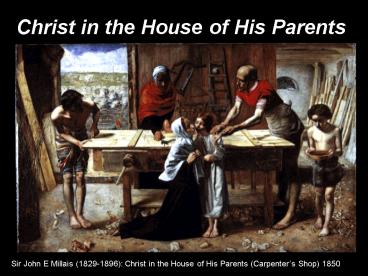Christ in the House of His Parents - PowerPoint PPT Presentation
1 / 10
Title:
Christ in the House of His Parents
Description:
Born on June 8, 1829 in Southampton into a prominent Jersey-based ... Pencil/paper sketch. ( 1850). Does not include the ladder, the dove, or John the Baptist. ... – PowerPoint PPT presentation
Number of Views:54
Avg rating:3.0/5.0
Title: Christ in the House of His Parents
1
Christ in the House of His Parents
Sir John E Millais (1829-1896) Christ in the
House of His Parents (Carpenters Shop) 1850
2
Sir John Everett Millais The Artist
- Born on June 8, 1829 in Southampton into a
prominent Jersey-based family. - Considered a prodigy in art, he was accepted
into the Royal Academy schools at the age of
eleven. (youngest student ever admitted) - There he established ties with William Holman
Hunt and Dante Gabriel Rosetti, who together
formed the Pre-Raphaelite Brotherhood in 1848. - His most controversial work was the Carpenters
Shop, the piece presented before. - Other famous works and contributions to the
movement Ophelia (1852) and various
interpretations of Tennysons poems. - Was famous for his intricate detail and
meticulous work.
3
Sir John Everett Millais Weird Facts
- He was really good friends with John Ruskin.
(Yeah remember him?) The critic, who at one point
was considered The Critic of England who liked
Gothic architecture, defended the Pre-Raphaelite
movement, etc. - Euphemia Gray, Ruskins wife, was used often by
Millais as a modelThat is until they fell in
love and she divorced him to marry Millais. - After Millaiss marriagehe happened to become a
more broader painter, and just so happened to
get the tongue-lashing from Ruskins critiques.
Ruskin at one point called his style a complete
catastrophe. - He was considered a sell out by his peers, in
order to become popular and wealthy. Some critics
believe that it was the resentment of his wealth - His style later on in life changed to a more
Impressionist outlook, and he admired the styles
of Velázquez and Rembrandt. - He was a publisher and illustrator for books,
which attributed greatly to his popularity. One
of which was Bubbles (1886). - Served as an associate member for Royal Academy
of Arts in 1853 and then a full member soon
after. - He was the first artist to be granted baronetcy
(the title of baron), a typically hereditary
title. - He was elected as the president of the Royal
Academy of Arts in 1896 but died of throat cancer
the same year.
4
Christ in the House of His Parents
So what about it?
5
Christ in the House of His Parents
The original sketch of Christ in the House of His
Parents (Carpenters Shop). Pencil/paper sketch.
(1850). Does not include the ladder, the dove, or
John the Baptist.
6
Christ in the House of His Parents
Relax, this is not a mistake/repeat.
7
Christ in the House of His Parents
- The painting was done in oil, and was completed
in 1850. - Millais actually used a real-life carpenters
shop on Oxford Street as his background layout. - The verse Zechariah 136 were depicted along
with painting - And one shall say unto him, what are these
wounds in thine hands? Then He shall answer,
Those with which I was wounded in the house of my
friends. - - The scene is a depiction of Jesus being
comforted after being injured. John is bringing
water and vinegar to disinfect the wound. - Symbols include
- The ever present theme of crucifixion
depicted as nails, the wood, the cut on little
- Jesus hand, the blood on his left foot, and
the vinegar (which was offered to him - at the crucifixion).
- Sheep in the background The image of Jesus
as a shepherd. - The dove The symbol of peace and innocence.
It also serves as a symbol of the - holy spirit.
- The heavy lighting and detail on the table
symbolizes the communion table. - John carrying the water and vinegar
symbolizing Jesus baptism. - - Currently it is displayed at the Tate Museum.
8
Christ in the House of His Parents
- The painting caused a huge controversy. The
painting was considered by many a blasphemous and
disrespectful representation of Jesus. - There were many who thought the plain and
normal depiction of Jesus unacceptable, one of
which was Charles Dickens. - Dickens described the image of Christ as a a
hideous, wry-necked, blubbering, red-haired boy
in a night-gown. - He also disliked the gloomy atmosphere and the
apparent depiction of a stereotypical alcoholic,
or low-class family, rather the depiction of the
sacred family. - Ruskin however, approved of the painting, and
supported it through both criticism and through
financial and social assistance to get the
Pre-Raphaelite artists known.
/
Image of Dickens, apparently angrily jeering at
the painting
9
Other Famous Works
Bubbles (1886)
The Blind Girl (1856)
Ophelia (1852)
The Boyhood of Raleigh (1871)
10
Sources
- Images (Ophelia/The Blind Girl/The Boyhood of
Raleigh) and information on Millais
Wikipedia.com - Tate Museums brief description
http//www.ready-to-hang.com/LCP_ArtNotes/Sir_J_Mi
llais_ChristChild.htm - Black and white image of Millais
http//www.iolaire.co.uk/heads/pages/Sir20John20
E20Millais.htm- Original drawing of painting
image and painting image http//www.victorianweb.
org/painting/millais/drawings/15.html- Bible
verse http//bible.cc/zechariah/13-6.htm- Image
of Dickens http//dickens.thefreelibrary.com/-
Image of Bubbles http//classicartrepro.com/paint
ing.iml?painting4549































